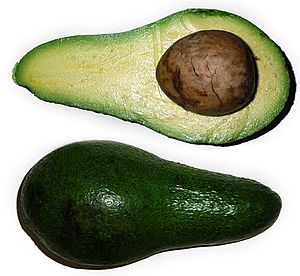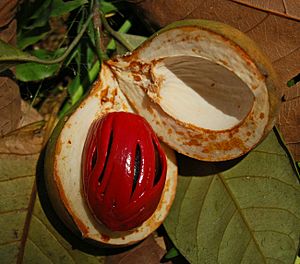Magnoliids facts for kids
Quick facts for kids Magnoliids |
|
|---|---|
 |
|
| Flower of Asimina triloba | |
| Scientific classification |
|
| Kingdom: | Plantae |
| Clade: | Tracheophytes |
| Clade: | Angiosperms |
| Clade: | Magnoliids |
| Type species | |
| Magnolia virginiana |
|
| Orders | |
|
Canellales |
|
Magnoliids are a big group of flowering plants. They are also called Magnoliidae or Magnolianae. This group has more than 10,000 different kinds of plants. Some well-known magnoliids include magnolias, nutmeg, bay laurel, cinnamon, avocado, and black pepper.
Magnoliids are the third-largest group of flowering plants. Only eudicots and monocots have more species. You can often tell a magnoliid by its flowers, which usually have parts in groups of three. Their pollen often has one opening, and their leaves usually have veins that branch out. Some magnoliids are very old types of flowering plants. They share some features with older plants like gymnosperms.
Contents
Plants We Use Every Day
Magnoliids are a very important group of plants for people. Many species are used for food, medicine, perfumes, wood, and as beautiful garden plants.
Delicious Fruits from Magnoliids

One popular magnoliid fruit is the avocado (Persea americana). People in Mexico and Central America started growing avocados almost 10,000 years ago! Today, avocados are grown all over warm parts of the world. The soft, creamy inside of the fruit is eaten fresh or made into guacamole.
Ancient people in Central America also grew other tasty fruits from the Annona plant family. These include the custard-apple (A. reticulata), soursop (A. muricata), sugar-apple (A. squamosa), and cherimoya (A. cherimola). Soursop and sugar-apple are now grown in many other parts of the world too.
Spices and Flavorings
Many magnoliids are used as important spices and flavorings in our food. These include black pepper, nutmeg, bay laurel, and cinnamon.

Oil from the sassafras tree was once used to flavor root beer and sarsaparilla. However, a main ingredient in sassafras oil, called safrole, is no longer used in food in many countries. This is because studies showed it could cause health problems in animals.
Medicinal Uses and Special Compounds
Not all plant compounds are harmful. For example, in the past, sailors used Winter's Bark from the South American tree Drimys winteri to help prevent scurvy. Scurvy is a sickness caused by not getting enough vitamin C.
Today, a substance called benzoyl is taken from the Lindera benzoin plant. It is used as a food additive and in skin medicines. This is because it can help fight bacteria and fungi.
Medicines from the bark of Magnolia trees have been used in traditional Chinese medicine for a long time. Scientists are studying compounds like magnolol and honokiol from magnolia. These compounds show promise for improving dental health. They can fight bacteria that cause bad breath and tooth decay.
Some plants in the Annonaceae family are also being studied for special chemicals called acetogenins. The first acetogenin found was uvaricin, which showed anti-leukemia properties in studies. Other acetogenins have been found that might help fight malaria and certain types of unhealthy cell growth. Some have even shown effects against certain viruses in lab tests.
Fragrant Oils and Perfumes
Many magnoliid species produce special essential oils. These oils are found in their leaves, bark, or wood. For example, the tree Virola surinamensis contains a fat called trimyristin. This fat is used to make soaps and candles.
Other fragrant oils are used to scent soaps and make Perfumes. For example, ylang-ylang oil comes from the flowers of Cananga odorata. This oil is used in perfumes, especially by women in Arab and Swahili cultures. A sweet-smelling "butter" is also made from the same tree that produces the spice nutmeg. This "nutmeg butter" is used in perfumes and as a lubricant.
See also

